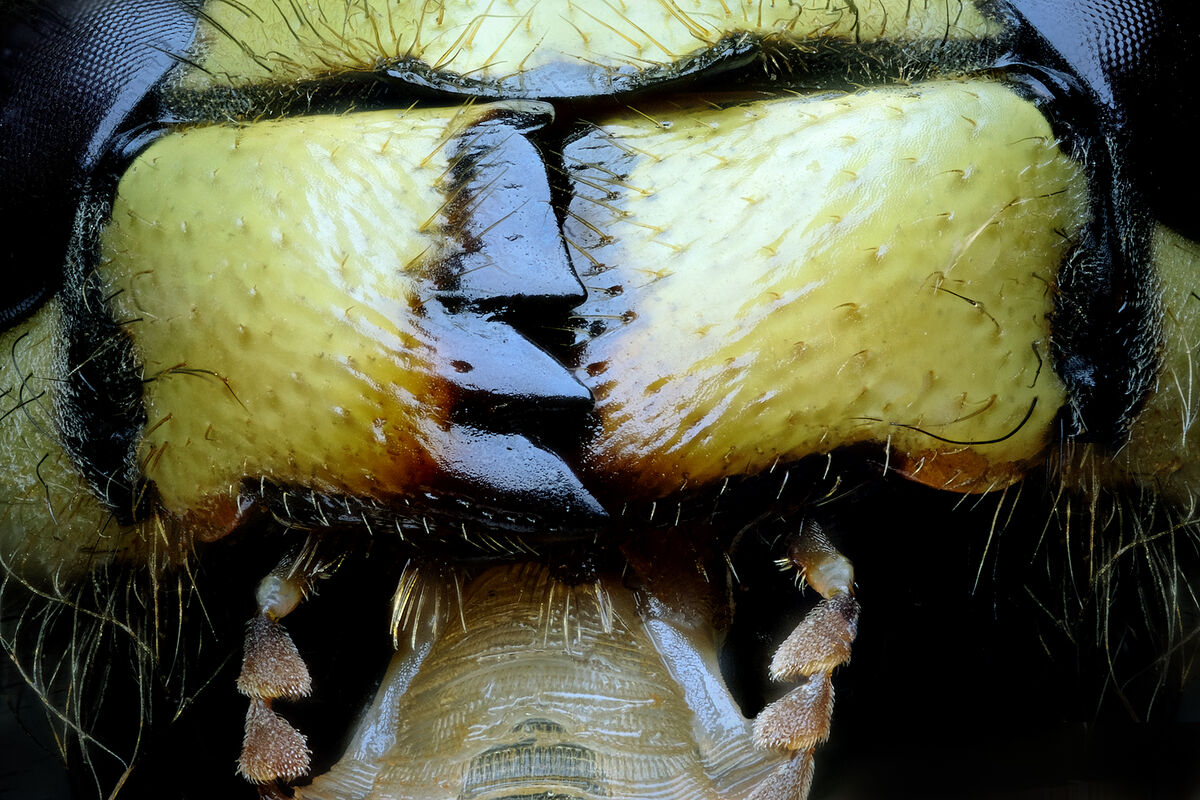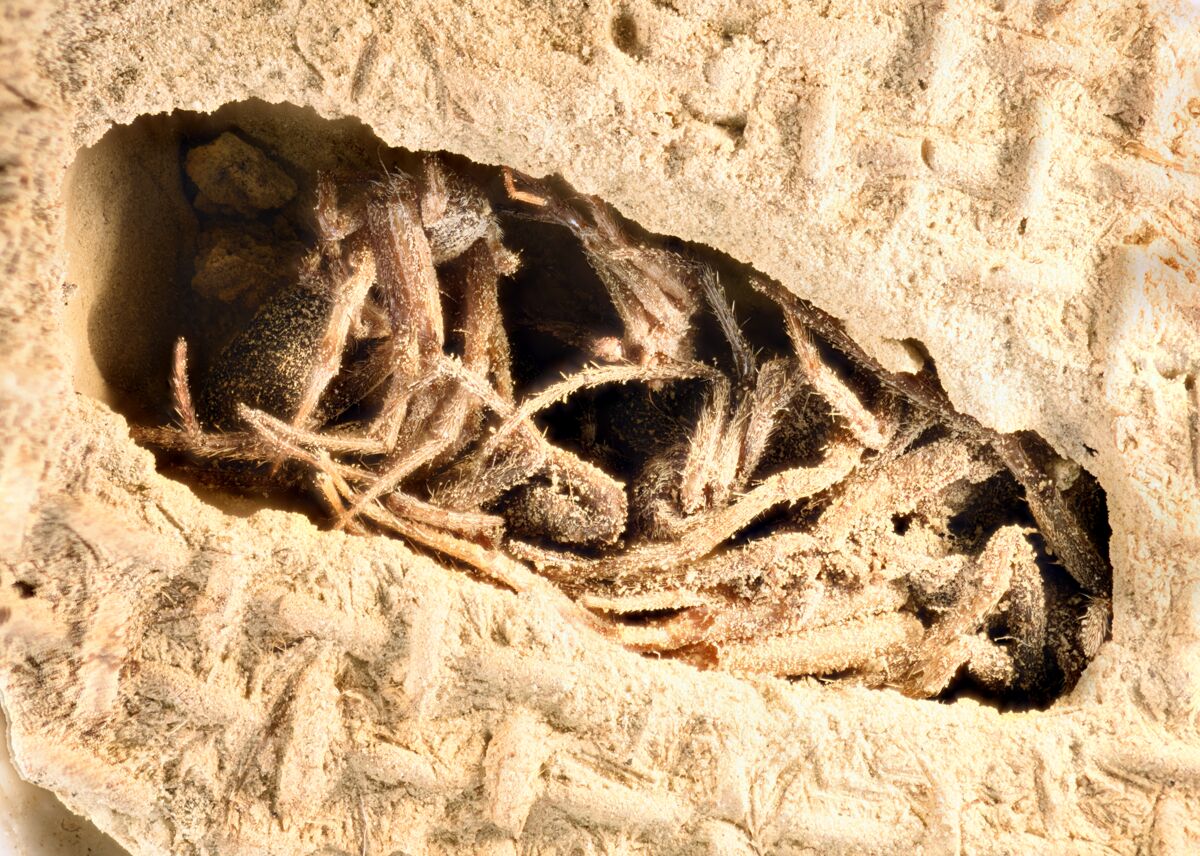Focus Stacked Image of Yellow Jacket Mandibles
Nov 21, 2022 20:41:15 #
This is a focus-stacked image of a yellow jacket's moth parts staged at 7.5X magnification. Their diets vary during their lifecycle.
Adults crave sugars and carbohydrates and they can be found foraging around the following foods:
Fruits, Flower, Nectar, Tree Sap, Fruit juices, and other foods rich in sugar. They collect these foods by sticking their long tongues (paraglossa) into the food source. A word of caution is to check your can of soda or beer before putting it in your mouth if you happen to be outdoors, for you may find a yellow jacket.
Yellowjacket larvae feed on proteins so they are good in controlling garden pests such as the following:
Flies, crickets, aphids, caterpillars, cabbage worms, grubs, moths, spiders, meat, and fish. For their larval stage, yellow jackets need protein. Adults hunt other insects and bring them back to the colony to feed the young, which are chewed and conditioned in preparation for larval consumption (hence the chewing mandibles). That’s also how gardeners benefit from yellowjackets in their yards! (just be sure to look into your soda and beer cans when outdoors).
They also eat dead insects also and it is estimated that in a 2,000-square-foot yard, yellow jackets consume more than two pounds of bugs in the form of live or dead insects.
Adults crave sugars and carbohydrates and they can be found foraging around the following foods:
Fruits, Flower, Nectar, Tree Sap, Fruit juices, and other foods rich in sugar. They collect these foods by sticking their long tongues (paraglossa) into the food source. A word of caution is to check your can of soda or beer before putting it in your mouth if you happen to be outdoors, for you may find a yellow jacket.
Yellowjacket larvae feed on proteins so they are good in controlling garden pests such as the following:
Flies, crickets, aphids, caterpillars, cabbage worms, grubs, moths, spiders, meat, and fish. For their larval stage, yellow jackets need protein. Adults hunt other insects and bring them back to the colony to feed the young, which are chewed and conditioned in preparation for larval consumption (hence the chewing mandibles). That’s also how gardeners benefit from yellowjackets in their yards! (just be sure to look into your soda and beer cans when outdoors).
They also eat dead insects also and it is estimated that in a 2,000-square-foot yard, yellow jackets consume more than two pounds of bugs in the form of live or dead insects.
Nov 21, 2022 20:47:51 #
Nov 21, 2022 20:50:46 #
Nov 21, 2022 21:04:08 #
Nov 21, 2022 21:05:47 #
kpmac wrote:
If they were any larger they could crack a hickory nut. Great stack, sippy.
Thanks, Kpmac. You should have zillions of them down your way so be on the lookout for them around your sugary drinks and teach the grandkids to look before putting them to their mouth.
Nov 21, 2022 22:04:11 #
sippyjug104 wrote:
This is a focus-stacked image of a yellow jacket's... (show quote)
Great info and your usual great work! Terrifying. Thanx for sharing!
Nov 21, 2022 22:47:52 #
Sinewsworn wrote:
Great info and your usual great work! Terrifying. Thanx for sharing!
Thanks, Tim. Wasp and their yellow jacket kin are fascinating as well as prehistoric creatures. I catch mine by hand so there is always that moment of truth as to who will get who and I have had some exciting moments. Solitary yellow jackets almost always go about their business. It's when the hive believes that it is threatened is where we don't want to be around. Yellow jackets tend to build their nests in the ground so it is easy to unknowingly come across them.
Here's a sure-fire way to clean out a hive of yellow jackets:
1. Get a plastic tub-type container, say 16 inches long x 6 inches wide x 4 or so inches deep.
2. Fill the container with water to about two inches to the top. Add a few good squirts of cheap liquid dish soap.
3. Get a piece of wood that is a bit longer than the tub and about four inches narrower so that it will lay on top of the tub and provide a gap on both sides.
4. Take a piece of raw chicken, like a back or a thigh, and screw it to the center of the board.
5. Place the board over the tub of water with the chicken side down. The water should be very close to touching the chicken.
6. Relax and have an adult beverage and watch the show.
The yellow jacket hive's main purpose is to feed the larvae protein. The scouts will find the chicken and they must fly through the gap on the sides to get to it. They will then land on the chicken and tear bits off of it. THEN when they push to fly off...they will land in the soapy water and sink to the bottom. Good Bye Yellow Jackets..!
7. Relax and have another adult beverage.
Nov 21, 2022 23:40:20 #
sippyjug104 wrote:
Thanks, Tim. Wasp and their yellow jacket kin are... (show quote)
I have a few adult beverages while editing for mightfall. After dark I shoot the the nest or hive with a camphor—based Yellowjacket killer. Works on paper wasps, mud daubers, Thread-wasted wasps, and Bald-faced Hornet. We have Paper wasp nests over our doors every Spring. They attack us so they must go. I understand that thin copper plates placed over repeatedly used nest locations works. Not tried it yet.
Nov 22, 2022 06:31:16 #
sippyjug104 wrote:
This is a focus-stacked image of a yellow jacket's... (show quote)
Another fantastic image!!!
Nov 22, 2022 07:29:58 #
Nov 22, 2022 08:33:56 #
Nov 22, 2022 09:18:25 #
Sinewsworn wrote:
I have a few adult beverages while editing for mightfall. After dark I shoot the the nest or hive with a camphor—based Yellowjacket killer. Works on paper wasps, mud daubers, Thread-wasted wasps, and Bald-faced Hornet. We have Paper wasp nests over our doors every Spring. They attack us so they must go. I understand that thin copper plates placed over repeatedly used nest locations works. Not tried it yet.
Tim, mud daubers are amazing creatures and they will not sting us. However, they are "spider hunters" and they sting and paralyze the spiders and carry them back to the mud clod nest where they have laid the egg. The supply of spiders provides the larvae with the protein meals they need. Here's a nest I found where the egg did not make it, showing all of the spiders the female had collected.
Nov 22, 2022 09:20:04 #
Manglesphoto wrote:
Another fantastic image!!!
Manglesphoto, thanks for the reply.
Nov 22, 2022 09:20:31 #
Nov 22, 2022 09:21:12 #
If you want to reply, then register here. Registration is free and your account is created instantly, so you can post right away.









